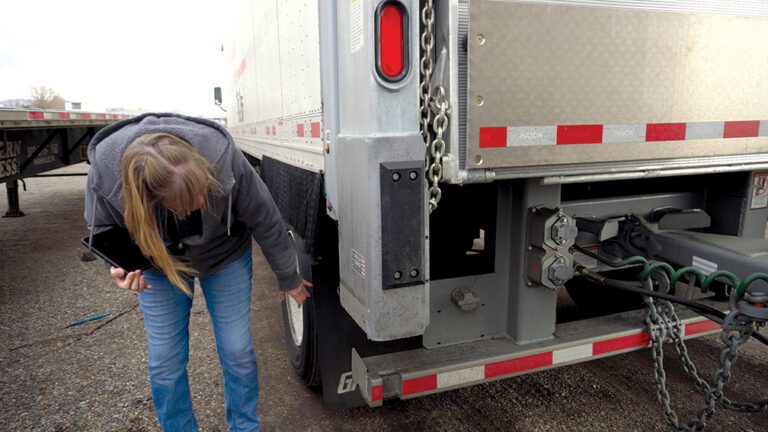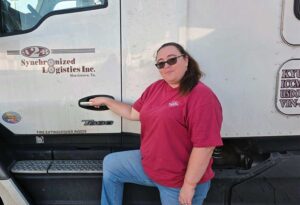Every truck driver is concerned about safety. Most have had hours of training, both formal and informal, and know to remain alert and attentive when driving. There are exceptions, of course, but every driver knows that the unexpected can happen at any time. Motorists are people — and people make mistakes.
Being prepared goes a long way to avoiding problems on the road.
However, safety precautions don’t end when you climb out of the driver’s seat. All too often, drivers are injured (or worse) through events that happen away from the wheel, or even outside of the cab. It pays to understand how to decrease risks everywhere in the workplace, even if “work” isn’t being performed.
One example is the simple act of getting in and out of the truck. On some vehicles, the steps are arranged like a small staircase or a common stepstool. It’s only a couple of steps, after all, until … wham! A slip, a fall and a serious injury can result. That’s why drivers are taught to maintain three points of contact when entering and exiting a vehicle.
“‘Slips, Trips, and Falls’ continues to be our largest contributor of injuries. It is imperative that drivers utilize three points of contact at all times when entering and exiting the vehicle” said Jim Smith, vice president of specialty safety for ProDrivers, a specialty brand of Employbridge, that provides contracted driving services to carriers.
“While some of the newer drivers have a tendency to jump from the step, some also are just leaving school and it is ingrained in them to use three points of contact,” he said, noting that whether it’s an attempt to work faster or a case of simply becoming lax over time, some drivers stop using the three points rule.
“As for the older drivers, sometimes complacency has set in, and we still see injuries from rushing while entering and exiting the vehicle,” he said, adding that this is not true for everyone. “On the flip side, it is still great to see the older men and women taking their time because they have seen the severity of not using three points of contact.”
Of course, wearing sturdy shoes or boots helps prevent foot and ankle injuries, but we’ve all seen other drivers climb down from the cab wearing shower shoes or flip-flops. Casual footwear may be more comfortable — especially when a driver is off duty — but that doesn’t make it a wise choice. More than a few drivers have been ambushed by poor traction and rough walking conditions. Losing a few weeks of pay while recuperating can be more painful than the injury itself.
Lighting is also an important factor when considering safety.
A flashlight can be invaluable when walking around the truck, especially when performing an inspection. When the lighting conditions are less than perfect, a flashlight helps the driver see the inside of wheels, springs, shackles, wiring and tubing, and even a fifth-wheel check to make sure it is properly engaged. A better pre-trip inspection means the truck is safer to drive. In addition, a flashlight can also help drivers avoid potholes, foreign objects or other hazards when walking outside the truck.
Even opening the trailer can be hazardous. Every year, drivers are injured by cargo that falls when the doors to van or refrigerated trailers are opened. Freight can shift around in transit, even when shrink wrap or other securements are used.
Never stand behind a door while unlatching it. Stand behind the door that you aren’t unlatching; this way, the closed door will provide a barrier between you and any falling freight. Once you’re sure no freight is falling, go ahead and open the door and secure it with the provided chain, a bungee cord, rope or whatever you have. Then, open and secure the other door.
Be on alert whenever you’re in an area where loading and unloading takes place. Watch out for forklifts or other loading equipment; the operators’ line of sight can be blocked by the cargo they’re carrying, and they may not see you.
Safety and security go together. It’s always a good idea to be aware of your surroundings when you’re out of the truck. That’s a process that begins before you park. Choose a spot that has some lighting and isn’t too secluded. For some, it’s tempting to find a deserted lot or spot where nobody is around. It may be quieter, but it offers less deterrent to potential criminals, so use caution.
Always use windows and mirrors to check the area around your truck before getting out, and pay attention to your surroundings while walking. Just as text messages and emails can distract you from driving, they can also distract you from potential hazards in your surroundings. Wait until you’re in a more secure situation to answer. Do keep your phone handy, however, in case you need to call 911.
Once you’re back in the cab, keep your doors locked. Some drivers use a strap to hold the doors together in case the locks are defeated. Criminals sometimes have remote entry codes or extra keys that can get doors open.
When you’re ready to roll, make sure all items are properly stowed and that nothing impedes your vision through windows and in mirrors (this includes dirt or smudges on viewing surfaces). Loose items can become projectiles in hard stopping situations, or they can fall onto the floor and interfere with the operation of the controls, creating a dangerous situation.
It’s important to remember that safety must be a part of everything you do in and around your vehicle, and not only when you’re driving. Every driver has heard this before, but a reminder never hurts.
Cliff Abbott is an experienced commercial vehicle driver and owner-operator who still holds a CDL in his home state of Alabama. In nearly 40 years in trucking, he’s been an instructor and trainer and has managed safety and recruiting operations for several carriers. Having never lost his love of the road, Cliff has written a book and hundreds of songs and has been writing for The Trucker for more than a decade.















